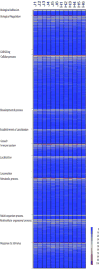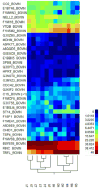Characterization of the bovine milk proteome in early-lactation Holstein and Jersey breeds of dairy cows
- PMID: 26391770
- PMCID: PMC4859431
- DOI: 10.1016/j.jprot.2015.09.024
Characterization of the bovine milk proteome in early-lactation Holstein and Jersey breeds of dairy cows
Abstract
Milk is a highly nutritious natural product that provides not only a rich source of amino acids to the consumer but also hundreds of bioactive peptides and proteins known to elicit health-benefitting activities. We investigated the milk protein profile produced by Holstein and Jersey dairy cows maintained under the same diet, management and environmental conditions using proteomic approaches that optimize protein extraction and characterization of the low abundance proteins within the skim milk fraction of bovine milk. In total, 935 low abundance proteins were identified. Gene ontology classified all proteins identified into various cellular localization and function categories. A total of 43 low abundance proteins were differentially expressed between the two dairy breeds. Bioactive proteins involved in host-defense, including lactotransferrin (P=0.0026) and complement C2 protein (P=0.0001), were differentially expressed by the two breeds, whereas others such as osteopontin (P=0.1788) and lactoperoxidase (P=0.2973) were not. This work is the first to outline the protein profile produced by two important breeds of dairy cattle maintained under the same diet, environment and management conditions in order to observe likely true breed differences. This research now allows us to better understand and contrast further research examining the bovine proteome that includes these different breeds.
Biological significance: Within the last decade, the amount of research characterizing the bovine milk proteome has increased due to growing interest in the bioactive proteins that are present in milk. Proteomic analysis of low abundance whey proteins has mainly focused on human breast milk; however, previous research has highlighted the presence of bioactive proteins in bovine milk. Recent publications outlining the cross-reactivity of bovine bioactive proteins on human biological function highlight the need for further investigation into the bovine milk proteome. The rationale behind this study is to characterize and compare the low abundance protein profile in the skim milk fraction produced from Holstein and Jersey breeds of dairy cattle, which are two major dairy cattle breeds in the USA. A combination of fractionation strategies was used to efficiently enrich the low abundance proteins from bovine skim milk for proteomic profiling. A total of 935 low abundance proteins were identified and compared between the two bovine breeds. The results from this study provide insight into breed differences and similarities in the milk proteome profile produced by two breeds of dairy cattle.
Keywords: Bioactive proteins; Low abundance proteins; Whey.
Copyright © 2015 Elsevier B.V. All rights reserved.
Figures



References
-
- Molinari CE, Casadio YS, Hartmann BT, Livk A, Bringans S, Arthur PG, Hartmann PE. Proteome mapping of human skim milk proteins in term and preterm milk. Journal of proteome research. 2012;11:1696–714. - PubMed
-
- Liao Y, Alvarado R, Phinney B, Lonnerdal B. Proteomic characterization of human milk whey proteins during a twelve-month lactation period. Journal of proteome research. 2011;10:1746–54. - PubMed
-
- D'Alessandro A, Scaloni A, Zolla L. Human milk proteins: an interactomics and updated functional overview. Journal of proteome research. 2010;9:3339–73. - PubMed
-
- Liao Y, Alvarado R, Phinney B, Lönnerdal B. Proteomic Characterization of Specific Minor Proteins in the Human Milk Casein Fraction. Journal of proteome research. 2011;10:5409–15. - PubMed
-
- Liao Y, Alvarado R, Phinney B, Lönnerdal B. Proteomic Characterization of Human Milk Fat Globule Membrane Proteins during a 12 Month Lactation Period. Journal of proteome research. 2011;10:3530–41. - PubMed
Publication types
MeSH terms
Substances
Grants and funding
LinkOut - more resources
Full Text Sources
Other Literature Sources
Research Materials
Miscellaneous

